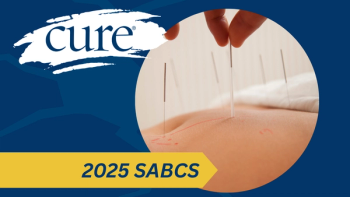
Intensive Vs. Non-Intensive Chemo Has Similar Results in Elderly Patients With AML
Elderly patients with acute myeloid leukemia did not experience a difference in relapse-free survival or non-relapse mortality with intensive versus non-intensive chemotherapy.
Elderly patients with acute myeloid leukemia (AML) did not experience a difference in relapse-free survival (RFS) or non-relapse mortality (NRM) with intensive versus non-intensive chemotherapy.
Researchers found no difference in RFS or NRM with intensive vs non-intensive chemotherapy after allogeneic hematopoietic stem cell transplantations in elderly patients with AML within their first complete remission (CR1), according to findings shown at the 2023 SOHO Annual Meeting.
At a median follow-up of 52.2 months, the two-year RFS (time a patient lives without experiencing death or disease relapse) rate was 51% with intensive therapy vs 50% with non-intensive therapy, showing no difference in outcome between the type of consolidation chemotherapy. A trend toward worse NRM was reported with intensive therapy, possibly related to complications such as infections, with a two-year rate of 27% vs 16% with non-intensive treatment. However, the difference was not statistically significant.
“The main takeaway from this study is that there is no impact of intensive vs non-intensive consolidation before hematopoietic stem cell transplantation in AML over 60 years old in CR1,” lead study author Dr. Yosr Hicheri, of the Department of Clinical Hematology at the Institut Paoli Clamettes in Marseille, France, said in a presentation of the data. “However, the study does have several limitations, including missing molecular data in nearly one-third of patients, the lack of measurable residual disease and the absence of detailed analysis of post-transplant complications.”
Prior analyses have shown conflicting data regarding the benefit of intensive vs non-intensive consolidation in elderly populations, Hicheri explained. As such, investigators set out to conduct a retrospective analysis over 10 years, from 2007 and 201, using the institution’s local Allograft database. Investigators included 130 patients over the age of 60 years in CR1 who underwent allogeneic stem cell transplant. A total of 68 patients had received non-intensive therapy consisting of low-dose cytarabine or azacytidine and 62 had received intermediate- or high-dose cytarabine.
Regarding baseline characteristics, the median overall age at transplant was 64 years (range, 60-72). Most patients (78%) had de novo AML, meaning that they did not have a history of prior myelodysplastic syndrome, myeloproliferative neoplasm or potentially leukemia-causing agents, as compared with secondary AML (22%). Most patients had intermediate- (38%) or adverse-risk (30%) disease per European LeukemiaNet 2017 criteria; 6% and 26% of patients had favorable risk and missing data, respectively. Most patients (73%) had undergone transplant within six months of diagnosis and had received matched unrelated donor/mismatched unrelated donor (42%) or sibling (37%) donor transplant. Conditioning regimens were largely reduced intensity (70%) or myeloablative (30%).
Additional results indicated that there was no difference in overall survival between the two cohorts, with two-year rates of 52% with intensive therapy vs 58% with non-intensive therapy.
In a multivariate analysis, cytogenetic risk was associated with worse RFS, with a twi-year rate of 34% compared with 56% in patients with intermediate or favorable cytogenetic risk.
Moreover, no difference in the rate of graft-vs-host-disease (GVHD) was reported based on consolidation regimen. Acute GVHD occurred in 44% of patients who received intensive therapy vs 50% of those who received non-intensive treatment. Chronic GVHD occurred less frequently but at similar incidence between the intensive and non-intensive cohorts (16% vs 12%).
“We now know that there’s no benefit of intensive chemotherapy. New drugs such as FLT3 inhibitors, CPX-351 (Vyxeos), and inhibitors of IDH have strongly modified the landscape of AML therapeutics. (Venclexta [venetoclax]) (plus) azacytidine followed by stem cell transplant results in an excellent outcome and likely improves outcome over maintenance therapy in newly diagnosed AML patients older than 60,” Hicheri stated. “The development of nonmyeloablative haploidentical stem cell transplant with peripheral blood cell and post-transplant cyclophosphamide is [also] very well tolerated and allowed long-term survival in elderly patients with AML or myelodysplastic syndrome. (We) now have four powerful tools for maintenance therapy after allogeneic stem cell transplant to maintain response.”
Hicheri concluded by highlighting an ongoing phase 2 study in which elderly patients with AML in CR1 following treatment with idarubicin, cytarabine, and lomustine will be randomly assigned to 6, 28-day cycles of treatment with Venclexta plus cytarabine or idarubicin and cytarabine. The primary end point is two-year RFS, and patients will be followed for a period of five years.
For more news on cancer updates, research and education, don’t forget to





